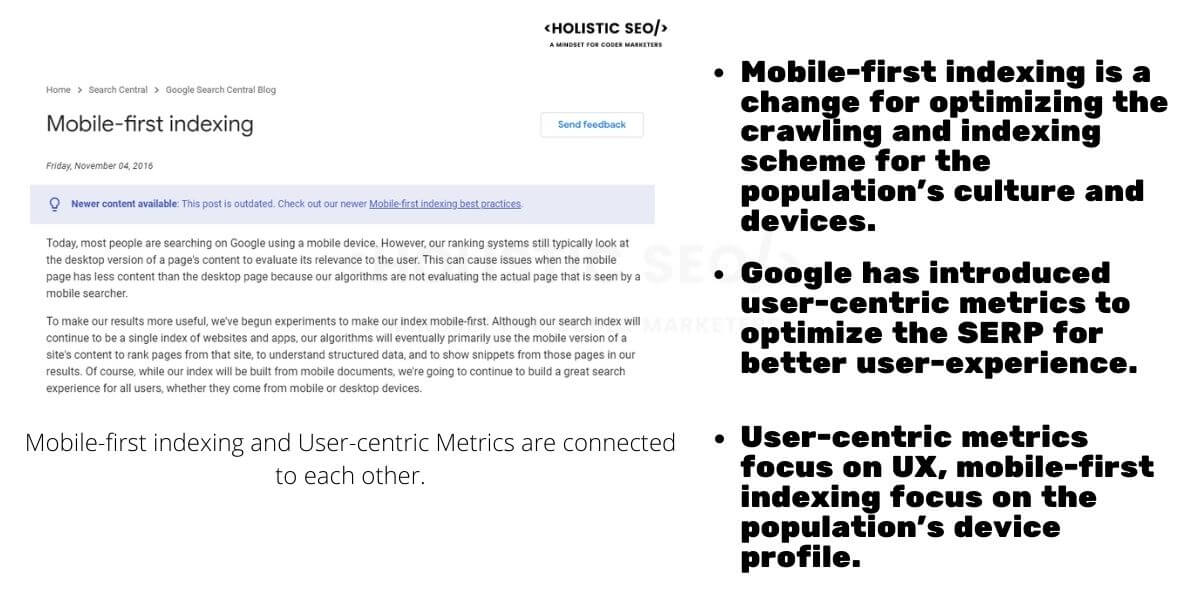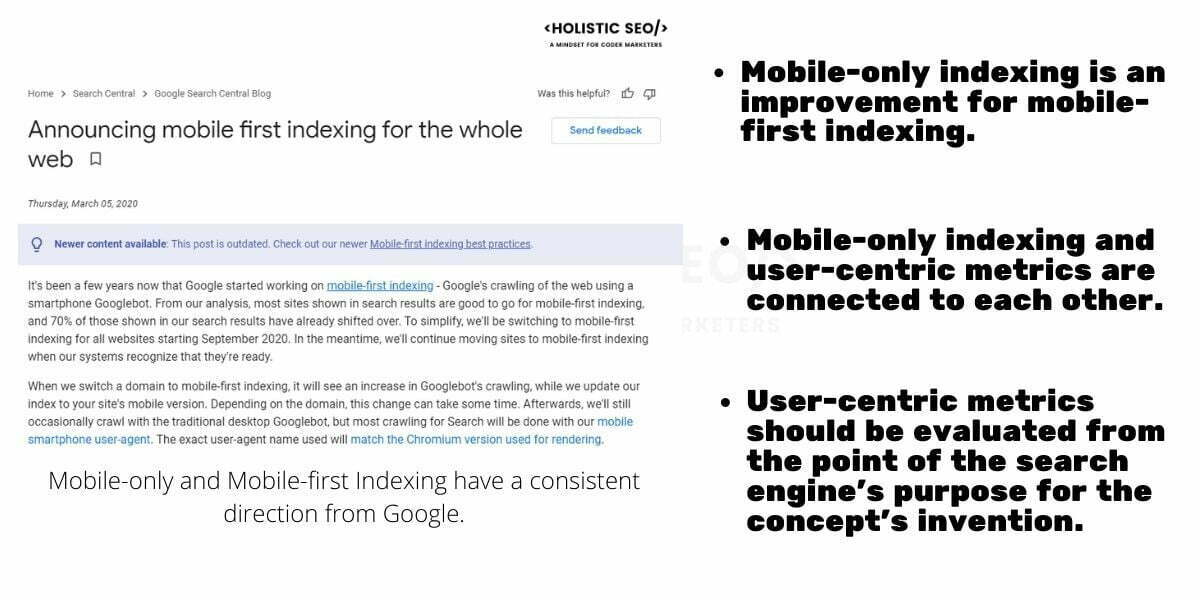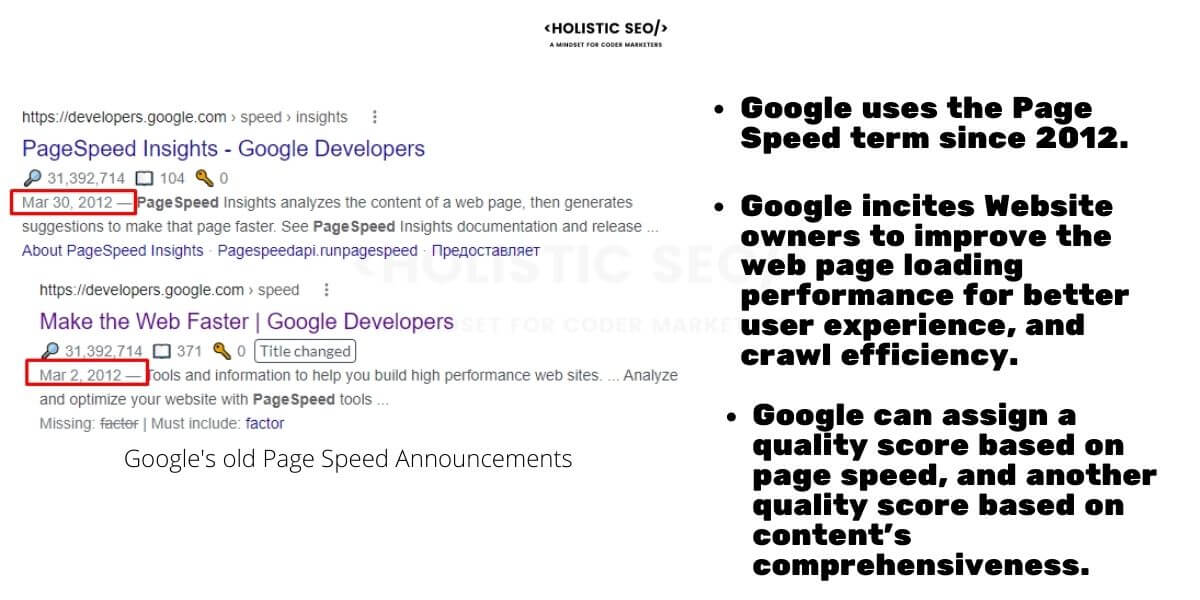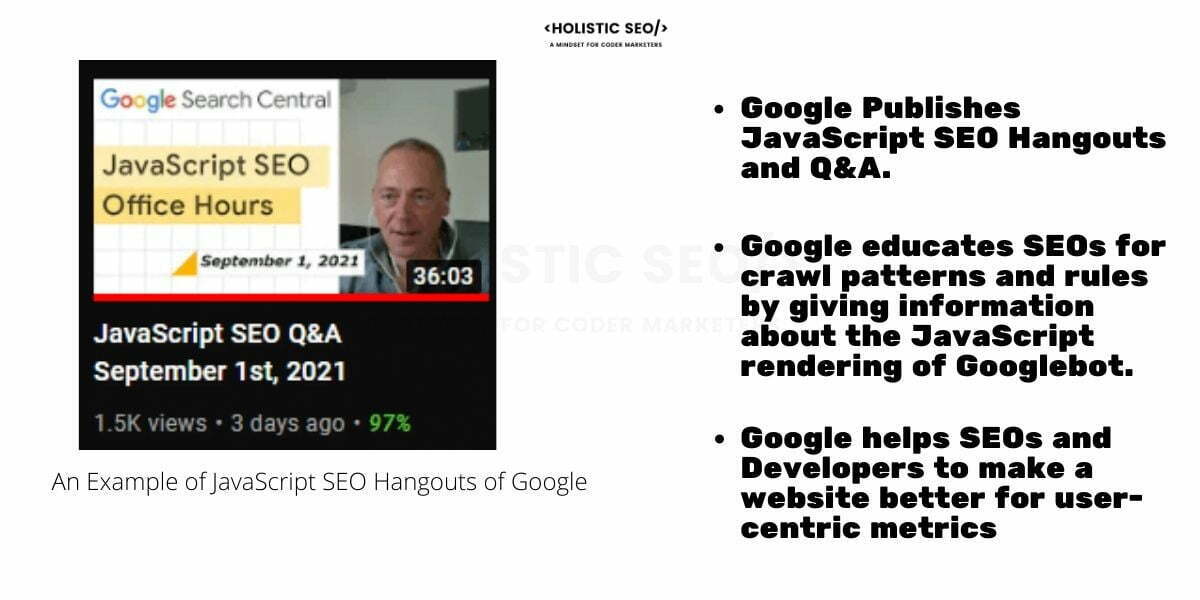User-centric web page speed performance metrics focus on different verticals that affect the perception of users for the page loading performance of a website. User-centric performance metrics are announced by Google Developers and W3C Web Performance Working Group to organize the concepts that are related to the Lighthouse. User-centric performance metrics involve the relativity of perception during the different stages of the web page loading process. From requesting the web page-related resources such as images, fonts, CSS, and JS files, and reading, parsing, rendering these resources are included within the user-centric metrics. The examples for the relativity of speed in user-centric metrics can be explained with the examples below.
- A slow website can be loaded as fast if the user’s device and internet connection are fast.
- A website can load itself at the 5th second suddenly, and it can be perceived as slower than a website that loads itself in 7 seconds gradually.
- A website that is loaded fast might be irresponsive, and block users from performing any event, and process.
- A website can be loaded fast, but the animations, and transitions might not be smooth.
To learn how every user interacts with the website, Google, and other search engines try to focus on user-experience reports such as Chrome User Experience Report more than lab data such as Lighthouse report. In this article, the user-centric performance metrics, their meanings, and connections to the web page speed metrics will be processed.
What are the four questions that defined the user-centric web page speed performance metrics?
The questions that are used for defining the user-centric performance metrics are listed below.
- “Is it happenning?” question focuses on the response time, and loading event’s starting poting.
- “Is it delightful?” question focuses on the whether the content is enough at the early stage of web page lifecycle or not.
- “Is it useful?” question focuses on whether the users are able to interact with the page or not.
- “Is it usable?” question focuses on whether the interactions are smooth or not.
All user-centric performance-related question tries to focus on different lifecycle stages of the web pages by measuring the web page’s usability, and user-friendliness. Instead of focusing on the timing of the “load” events, developers started to focus on more useful user-centric metrics to understand how the web page is efficient to satisfy the search intent and the visit intent of the users or not.

How are the User-centric Metrics measured?
There are only two ways to measure the user-centric performance metrics, which are “In The Lab”, and “In the Field”.
- In the Lab: user-centric metrics can be measured by simulating an artificial user experience to load the web page by measuring every response of the web page to the browser automation system.
- In the field: user-centric metrics can be measured by collecting the user feedback, and user behaviors from the browsers with user monitoring systems.
- Real User Monitoring: user-centric metrics can be measured as live to see how the users interact with the web page. Live user tracking to see the user-centric web page speed metrics can help a developer, and SEO to see the improvable points within a web page better.
Although there are certain ways to measure user-centric metrics and the methodology to measure user-centric metrics are very strict, the commentary and the meaning of the data obtained can change according to the measured medium.
What are the “In the Lab” methods for user-centric metric measurement?
To measure the user-centric performance metrics within the lab, the tools and technologies below can be used.
- Performing a Lighthouse test within the Chrome Browser.
- Using Lighthouse NPM Package within the local machine with a performance budget.
- Using GTMetrix to see how the web page response to the requests.
- Using WebPageTest to see the performance metrics, waterfall, and further customized analysis of a web page.
The main advantage of the in-the-lab methods for user-centric metric measurement is to provide instant, and bulk feedback from the web development changes for page speed. All of the lab data will be lack in terms of the real user metrics (RUM). Thus, supporting the information that is gathered from lab data for user-centric metrics is important to have a better, and realistic web page speed optimization strategy. The main advantage of the lab data is having instant feedback from the web page loading simulators while developing and improving the web pages. Since, real-world users’ data can flow slower, performing a bulk web page loading test with page speed tools is useful to have faster feedback for possible, and future improvements. Using lab data from multiple sources can give more suggestions, diagnoses, and improvement plans for the user-centric performance metrics. To learn the best page speed test tools, you can read the related guide.
In the lab methods, being one of the three ways of measuring the user-centric metrics, is widely used by various mediums like Task Completion Time (TCT), Interaction to Next Paint (INP), and many others due to the advantages above. To exemplify, Interaction to Next Paint heavily relies on Lighthouse as a webpage loading performance tester which is mentioned above as one of the tools that can be used to follow “in the lab” methods to measure user-centric metric.
What are the “In the field” methods for user-centric metric measurement?
To collect Real User Metrics (RUM) for user-centric performance metrics’ measurement, the methods below can be used.
- Creating a Chrome User Experience (CrUX) Report.
- Collecting user-centric metrics with Google Tag Manager
- Collecting user-centric metrics with Google Analytics
- Using Dareboost, Site24x7, Tek-tools, Pingdom for collecting user-centric performance metrics.
- Using Pagespeed Insights API and Tool
The advantage of the in-the-field methods for user-centric metric measurement is to provide real user metrics in bulk to help the development team of the website. Using in-the-field methods for user-centric performance metrics can provide a better understanding of the conversion rate, user experience, and users’ feelings while using the website. Thus, improvements can be done with more data and better empathy from visitors. In this context, the lab data, and the field data for user-centric metrics should be used together.
As mentioned above, there are various methods to measure user-centric metrics under the “in the field” category and these methods are commonly used by various mediums just like the “in the lab methods”. One of those mediums who uses in the field methods is “Interaction to Next Paint (INP)”. Interaction to Next Paint relies on Chrome User Experience Report (Crux) data to explain what percentage of the users interacted with a good or bad INP score.
What are the Real User Monitoring methods for user-centric metric measurement?
Real User Monitoring methods for user-centric metric measurement are listed below.
- Using a user monitoring technology such as Hotjar, and Microsoft Clarity
- Using Google Analytics events with Google Tag Manager for real-time user monitoring in the context of user-centric metrics.
- Using Puppeteer, and custom JavaScripts for measuring the timings of user-centric metrics.
Real-time User Monitoring can be done to understand how the website and the webpages are performing at that very specific time. To improve the user-centric performance metrics, real user monitoring can be used along with in the field, and in the lab methods.
What are the Types of User-centric Web page Performance Metrics?
There are five types of user-centric web page performance metrics. User-centric metric types are Perceived Load Speed”, Load Responsiveness, Runtime Responsiveness, Visual Stability, and Smoothness. The types of user-centric web page performance metrics and their definitions along with functions are listed below.
- Perceived Load Speed measures the perception of the web page speed during the web page loading phase (early stage of web page lifecycle). If a web page doesn’t create a fast loading perception, it can cause users to loose their focus and concentration to use the web page.
- Load Responsiveness, measures whether the web page is able to respond to the users’ input events during the loading of the web page. If the user is not able to perform its visit intent for the web page, it means that web page doesn’t have load responsiveness.
- Runtime Responsiveness, measures the responsiveness after the web page is loaded. If a web page doesn’t respond to the user during the active state of the web page, it means that loading the web page fast or slow doesn’t make a difference for user experience.
- Visual Stability measures how the visible elements on the web page is stable. Unwanted, and unexpected shifts within the web page’s layout can cause stress and dissatisfaction of users.
- Smoothness measures the transitions, animations and changes on the web page with Frames per Second (FPS). Smoothness as a user-centric web page performance metric measures the web page’s quality for visual communication with the web page user (visitor).
Which page loading performance metrics are connected to the user-centric performance metrics?
The web page loading time performance (page speed) metrics that are connected to the user-centric metrics can be found below.
- First Paint is connected to user-centric performance metrics because perception of speed and first pain are relevant. If first paint is slow, or late, the user won’t be able to perceive the visual change during the loading of the web page.
- First Contentful Paint is connected to user-centric performance metrics because first contentful paint and first meaningful paint will affect the perception of the user for page speed. A slow, and non-important first contentful paint, and the first paint will cause users to think that the web page is slow, even if it loads in fewer time.
- Largest Contentful Paint is connected to user-centric performance metrics because LCP Element is assumed as the functional part of the web page to reflect its purpose. If the most important, and functional part of the web page is not laoded fast enough, it can harm the perception of speed.
- First Input Delay is connected to the user-centric page speed metrics because First Input Delay (FID) is related to the “Load Responsiveness” and “Runtime Responsiveness”. If the web page doesn’t respond a user during the web page loading, and web page usage stages, the First Input Delay will be higher. FID can be caused due to exessive amount of web page resource requests that can block the main thread of the browser. If the main thread is blocked, it can’t answer the input of the user, and it can cause FID by harming the load responsiveness and runtime responsiveness.
- Time to Interactive is connected to the user-centric performance metrics because Time to Interactive (TTI) measures when the web page is fully responsive, and loaded. To measure it, TTI tries to catch the “quiet window” of the web page loading process. If a web page is fully loaded, and there is no long task in the browser main thread, it means that the web page is fully responsive. If the TTI is late, or problematic, it can harm the “runtime responsiveness”, and the “load responsiveness”.
- Total Blocking Time is connected to user-centric performance metrics because Total Blocking Time (TBT) measures the total time that users’ couldn’t interact with the web page. Total Blocking Time is connected to the load responsiveness, and runtime responsiveness directly. A high total blocking time can be a signal for visual smoothness and perception of speed related problems. High TBT and slow web page loading time are correlated to each other because it means that the browser couldn’t process everything as it should due to the high request count, slow connection, or total request size, and unoptimized web page for better page speed.
- Speed Index is connected to the user-centric performance metrics because Speed Indek and “Smoothness”, “Perception of Speed”, are related. If a web page doesn’t change the frames, and their content at the above the fold section of the web page during the web page loading phase, it means that the web page doesn’t process all the requests with the necessary speed. It can harm the perception of speed since the web page’s upper section stays frozen for longer times than 2, or 3 seconds.
- Cumulative Layout Shift is connected to user-centric performance metrics because Visual Stability and Cumulative Layout Shift are related. Cumulative Layout Shift shows how a web page’s components, and their layout shift their places during the web page loading phase without the consent and expectation of the user. Cumulative Layout Shift can cause stress, and material lost such as money, or unwanted misleading clicks. It can disrupt the visual communication, and delay the web page’s serving to the user with a better way.
- Interaction to Next Paint (INP) is a user-centric metric that significantly contributes to web page loading time performance, commonly known as page speed. INP measures the time it takes for users to interact with a webpage after initiating an action, such as clicking a link. A lower INP indicates quicker user interactions, directly enhancing the overall responsiveness of the webpage and contributing to a more satisfying user experience. By focusing on optimizing INP, developers and website owners effectively improve this crucial aspect of user-centric performance, aligning with broader efforts to enhance page speed and overall web performance.
User-centric metrics and page speed metrics are related and connected to each other to satisfy the user in a better way. The page speed metrics such as CLS, TTI, LCP, and TBT can change their definition based on user-centric metrics’ definition. Because, the main purpose of page speed measurement is to see how the web page satisfies the user, or how it serves to visitor’s purposes. Core Web Vitals as a quick grouping method for critical signals for page speed is created to see how well the user is interacting with the web page along with how fast the web page can respond, and load itself. Thus, user-centric metrics and page speed metrics should be handled, processed, and used together for better page speed improvement and optimization analysis, and projects.
What are the Custom Metrics for User-centric Performance Metrics?
A developer or SEO can create custom metrics for understanding how well the user interacts with the web page, and how the web page is loaded. A custom metric can focus only on the web page font files loading time, or only the featured images’ loading time. A custom user-centric metric can be created to measure a specific behavior on the web page such as response time for a specific file type, or resource download completion times after a new server migration. Custom user-centric performance metrics can help to understand a search engine’s decision tree for ranking based on the cost of websites, and user experience, along with conversion behaviors of the users, and their average session, and patterns for interaction on the web page.
What APIs can be used for Custom Metrics in the scope of User-centric Metric Performance?
To create custom user-centric performance metrics, the APIs below can be used from Google Chrome’s ecosystem.
- User Timing API is to provide high level precision for the user interaction time stamps.
- Long Tasks API is to recognizing the long tasks, and solving them by blocking other requests to give browser’s main thread time.
- Element Timing API is to measure the visibility time of the large elements on a web page such as text nodes, or images.
- Navigation Timing API is to understand the exact navigation events between web pages such as
- Resource Timing API is to measure the exact completion timing for loading resources.
- Server timing is to create an interface to see the server response timing for every resource on a web page.
These APIs can be used for creating custom user-centric metrics. By creating custom user-centric metrics, the information for user-interactivity can be collected in a better way. Thus, for conversion rate optimization, and search engine optimization, performing a better analysis will be more effective.
What are the side contexts of User-centric Performance Metrics?
User-centric performance metrics are mainly about web development and user experience along with search engine optimization. To understand the user-centric performance metrics, understanding the web page speed metrics, their necessity, and the logic behind them is a must. Side context of user-centric performance metrics can include the reasons for their existence and changes along with announcements that explain their necessity such as SERP Quality, Mobile-only indexing, Mobile-first indexing, Mobile-first design, and Click Satisfaction along with Search Intent.
What is the relevance of user-centric metrics to Mobile-only Indexing?
Mobile-only indexing involves indexing only the mobile version of a web page with its content. The desktop version of a web page is not evaluated for indexing, and if a content piece doesn’t exist within the mobile version of a web page, it will be excluded from the index, and it won’t be evaluated for ranking algorithms. Mobile-first indexing and mobile-only indexing are different from each other. Mobile-first indexing focuses on the mobile version of a web page but it indexes both versions as is while mobile-only indexing only indexes the mobile version of a web page. Google uses mobile-only indexing since the 5th March 2020. Google announced mobile-first indexing on 4th November 2016.

Mobile-only indexing and mobile-first indexing, and overall mobile usability of a website are connected to the user-centric performance metrics. Mobile-first indexing and mobile-only indexing show that the search engine focuses on the general quality of a website based on the web surfing device types of the population on the open web. Since more than 70% of online web sessions are performed over a mobile device, the search engine tries to decrease its cost for crawling, and indexing while improving the quality of the search engine result pages. If a web page is not convenient for users, if it doesn’t have load responsiveness, smoothness, or visual stability and good scores from other user-centric performance metrics, it means that even if the web page is relevant, it might decrease the quality of the SERP, click satisfaction while harming the prestige of the search engine’s itself in the eyes of web search engine users.

What is the relation between User-centric Metrics and SERP Quality?
Search Engine Result Page (SERP) is created by a search engine from the web pages that it crawled, and indexed to satisfy a need behind the query. To let a user perform its search intent within the SERP, a search engine should gather web pages from the open web that are relevant, reliable, quality, and fast. Quality signals of a search engine can change based on implicit user feedback and selection over time. A search engine can change the rankings of a web page on the search engine result page by focusing on different quality, usability, and reliability signals over time. Weighting different ranking factors, and aligning ranking signals by crawling different web pages for different queries is a complex process that requires information retrieval, fact extraction, and web crawling technologies. SERP Quality is the overall quality of web pages that are linked by the search engine. A search engine creates SERP to satisfy the users. If web pages are not quality, reliable, and fast enough to respond to a user, the user won’t be able to perform their purpose. Thus, user-centric performance metrics and search engine result pages are related to each other based on overall SERP Quality and Website Quality.
A search engine might change sources (websites) on the search engine result pages based on their performance for user-centric web page loading metrics such as visual stability, and smoothness. In this context, SERP Quality is the overall quality of websites from SERP for different verticals of website quality including user-centric metrics.
What is the relation between user-centric metrics and Search Intent?
The relation between user-centric metrics and search intent is connected to the click satisfaction and users’ purpose for visiting a landing page from SERP. Search Intent is the purpose of the user on the search engine result page after performing a query on the web search engine. A search engine result page may or may not contain the relevant document for the user’s search intent. Search intent and click satisfaction are connected to each other. Click satisfaction is satisfying a click purpose with the clicked web page’s content. A click satisfaction can be performed on quality websites and web pages on the search engine result pages. Thus, search intent, and user-centric metrics are connected to each other to improve click satisfaction and help users to perform their search intent faster, and more user-friendly experience.
What is the relation between User-centric Metrics and Mobile-first Design, and Usability?
The relation between user-centric metrics and mobile-first design is the characteristics of devices that users use for surfing on the web. User-centric metrics focus on the conditions of users to provide a better user-friendly experience on web pages. To provide a better user-friendly experience, user-centric metrics should be shaped based on users’ devices, and internet connections. Providing a good web page opening and user experience for even bad internet connections and old mobile devices is a must for better user-centric metrics performance and scores. In this context, the mobile-first design focuses to provide better usability for websites by designing, and coding websites predominantly for mobile users.
Mobile-only indexing and mobile-first indexing are connected to the mobile-usability. The user-centric performance metrics should be evaluated in the context of devices that users use to surf on the web. Mobile-first design websites and user-centric performance metrics are connected to each other in the context of satisfying the main target audience on the open web.
Last Thoughts on User-centric Performance Metrics and Holistic SEO
User-centric metrics and SEO are related to each other since search engine optimization becomes more user-centric rather than rule-based algorithms that focus on quantities, and certain deterministic principles. Google has announced that page speed is a ranking factor in 2018 with the blog post of Ilya Grigorik and Addy Osmani. Before the official announcement of Google, page speed-related incentives from Google has continuously published. It has been perceived as a ranking factor since 2012, Google published the Page Speed Insights and speed guidelines in 2012.

While I am writing User-centric web page loading performance metrics guidelines, Google Search Central continues to publish videos to improve the First Input Delay and other types of page speed-related videos.

At the same time, Martin Splitt from Google publishes JavaScript SEO Hangouts as below.

Google Search Engine continuously publishes new content related to the user-centric performance metrics for better page speed, user experience, and better crawl efficiency for the websites. Search engines use their communication channels to create cultural change among SEOs, developers, and website owners to prevent spam and make them focus on user experience by providing better crawlable websites. The main focus of user-centric performance metrics is keeping websites usable because if a website is not usable, even if it is speed, or relevant, it means that the website won’t be able to satisfy the users. Thus, a search engine can check the website’s web pages’ lifecycles, events, and performance for usability. In the context of usability, user-centric metrics and mobile-first indexing, mobile-only indexing, and evergreen Googlebot sub-topics are related as well.
In the context of Holistic SEO, the user-centric web page loading performance metrics should be evaluated as a result of the general change of the Google search engine over years.
The user-centric performance metrics guideline will be updated in the light of new information over time.
- Sliding Window - August 12, 2024
- B2P Marketing: How it Works, Benefits, and Strategies - April 26, 2024
- SEO for Casino Websites: A SEO Case Study for the Bet and Gamble Industry - February 5, 2024


